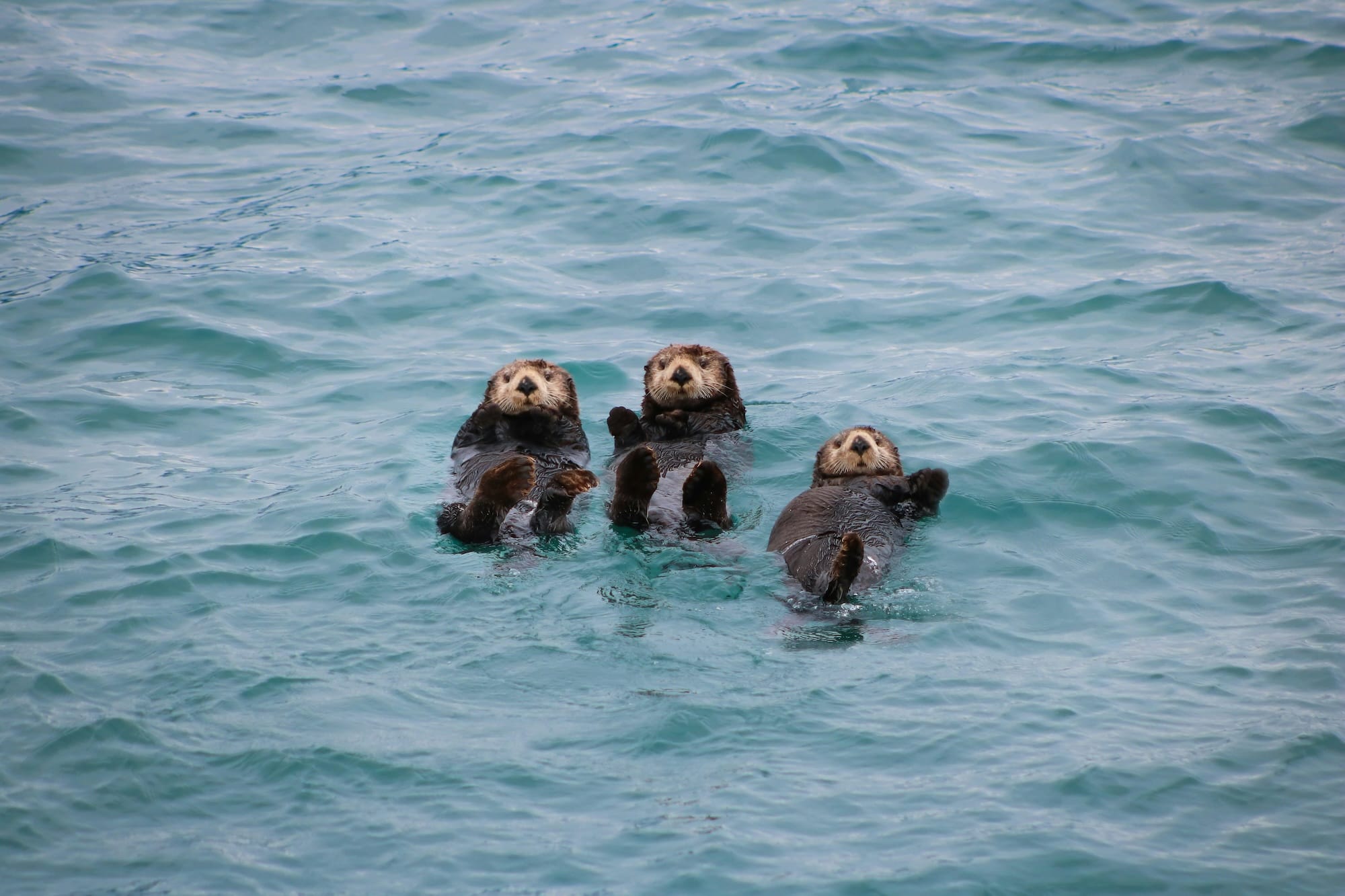Sea Otters (Enhydra lutris)
Dive into the intriguing life of sea otters, exploring their behaviors, diet, and vital ecological role, along with the conservation challenges they face.

Sea otters (Enhydra lutris) are more than just adorable creatures; they play a crucial role in the marine ecosystem. With their distinctive appearance and playful antics, they've captured the hearts of many. Yet, these charismatic animals face numerous challenges, many stemming from human activities. This post dives into the enchanting world of sea otters, their unique characteristics, the vital role they play in their habitat, and how our actions impact their survival. By understanding and appreciating these marine mammals, we can better advocate for their protection and the health of our oceans.
Physical Characteristics and Behavior of Sea Otters
Sea otters, the smallest marine mammal, are listed in Appendix I of CITES as endangered. They inhabit the Northern coastal areas of the Pacific Ocean along near-shore rock or soft-bottom coastal waters and in dense kelp forests. Sea otters live 15-20 years and are an average 4.5 feet long, though some grow up to 6 feet in length. Males weigh 70-90 pounds and females 40-60 pounds. Their marine environment required them to evolve certain skeletal, dental, and pelage adaptations.
The sea otter skeleton is loosely articulated and lacks a clavicle therefore increasing flexibility in swimming and grooming. They have short, retractable claws on their forelimbs, long hind limbs with broad, flat, webbed flipper-like paws, and a strong rudder-like tail. The hind paws exhibit an extension of the fifth digit to increase area to keep afloat when resting.
The sea otter diet consists of clams, sea urchins, snails, mussels, octopus, and occasionally small fish or sea birds. Small prey is swallowed whole, but larger prey is crushed with flattened molars and the four lower incisors. Sea otters will dive 5-250 feet for their food for a minute to a minute and a half. They can last up to four minutes underwater. Sea otters locate their prey with vision and touch then capture it with their forepaws. Loose skin at the armpit is used to store and transport food to the surface. Their metabolic rate requires them to eat at least 25% of their body weight daily.
The sea otter has the densest mammal fur, 120,000-140,000 hairs/cm2. Their coat is reddish-brown and coated with natural oils that make it waterproof. Their fur is split into oval-shaped bundles of wool hair surrounding one primary hair follicle. These hairs are flexible, interlock during grooming, and trap air inside them, creating a layer of insulated air heated by the body. Grooming consists of rubbing, rolling, and blowing air into the fur. This thick fur protects sea otters against extreme temperatures.
Social Structure and Behavior
Sea otters congregate in same-sex groups called rafts. Females begin breeding between two and four years old. Males sexually mature by the age of six. Males establish territory several years later and each male has several females all to himself. The male bites onto the female’s nose during mating, leaving visible scars. Mating is year round and pregnancy lasts anywhere between four and twelve months.
Pups are born one at a time since females can only successfully raise them at this pace. Pups are born weighing three to five pounds, nursed from the mother’s two mammae, and carried on her chest. The mother constantly grooms her pup to ensure the pup’s fur is buoyant and well insulated. Pups are left at the surface while the mother forages until the pup matures and can follow. Once they can follow they learn how to forage from their mother. There is no paternal care for the young. Pups stay with their mothers three to six months.
Role in the Ecosystem
Sea otters, as a keystone species, play a critical role in maintaining the health and stability of marine ecosystems, particularly kelp forests. Their diet, predominantly consisting of sea urchins, is a key factor in this ecological role. By controlling sea urchin populations, sea otters prevent these creatures from overgrazing on kelp, thus preserving the kelp forests. These underwater forests are not only vital habitats for various marine species but also serve as significant carbon sinks, highlighting the broader environmental impact of sea otters beyond their immediate habitat.
Human Impact
The species Enhydra lutris is classified as endangered since 1911. Commercial fur trade pushed the species toward extinction until an international protection treaty was established. The Exxon Valdez oil spill caused the death of thousands. Today environmental toxins, commercial fishing, and logging activities on the coasts reduce the sea otters’ natural habitat. Along the Russian coast sea otters are still hunted for their fur.
The Marine Mammal Protection Act (USA) and Species at Risk Act (Canada) are the first step for modern conservation. The U.S. Fish and Wildlife Service is attempting to manage damaging human activities.
Conservation facilities, such as Monterey Bay Aquarium and Long Beach Aquarium in California, are working with the species in order to release them and repopulate the sea otters. So far, there have been several reintroduction attempts.
If we take care of our planet, we help sea otters too.
References
- Cole, David N. and Laurie Young. Beyond Naturalness: Rethinking Park and Wilderness Stewardship in an Era of Rapid Change. Washington, D.C.: Island Press, 2010. Print.
- Corn, Lynne and Claudia Copeland. Deepwater Horizon Oil Spill: Costal Wetland and Wildlife Impacts and Response. Washington D.C.: Congressional Research Service, 2010. Print.
- Gunderson, Aren. “Enhydra lutris.” Animal Diversity Web. University of Michigan Museum of Zoology, 2002. https://animaldiversity.org/accounts/Enhydra_lutris/
- Hooper, C.L. Captain R.C.S. Sea Otter Banks of Alaska. Washington D.C.: Government Printing Office, 1897. Print.
- Hunt, Joe. Mission Without a Map: The Politics and Policies of Restoration Following the Exxon Valdez Oil Spill. Alaska: EVOS Trustee Council, 2009. Print.
- International Environment House. CITES. “Appendices I, II and III.” Cites, June 2007: 7. Print.
- Lehman, Jeffrey. “Magnificent Monterey.” San Diego: Travels. March 2006: 14. Web.
- McMichael, Anthony J. and World Health Organization. Climate Change and Human Health: Risks and Responses. Geneva: World Health Organization, 2003. Print.
- Raven, Peter H. et al. Nature and human Society: The Quest for a Sustainable World. Washington D.C.: National Academy Press, 1997. Print.
- U.S. Fish and Wildlife Service. “Northern Sea Otter in Alaska (Enhydra lutris kenyoni).” Wildlife Biologue. Alaska: U.S. Fish and Wildlife Service, 2005. Web.
- Watson, (Dr.) Jane. “Sea Otter – Enhydra lutris.” ARKive. Malspina University-College, 17 October 2007. Web. 23 November 2010.
- Wilkinson, Todd. “Marine Mystery.” National Parks. March-April 2000: 20-25. http://www.npshistory.com/npca/magazine/mar-apr-2000.pdf
Tags: research essay
Thanks for reading! If this helped or you learned something, Buy Me A Coffee.
 m2creates
m2creates